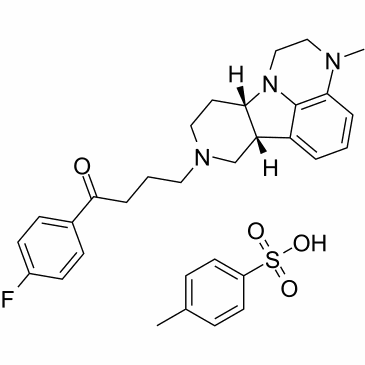Lumateperone tosylate
Cat. No. :YN321242

CAS No. :1187020-80-9
Pack size
price
inventory
5mg
Enquiry
Enquiry
10mg
Enquiry
Enquiry
25mg
Enquiry
Enquiry
50mg
Enquiry
Enquiry
 86-020-82000279
86-020-82000279 sales@ubiochem.com
sales@ubiochem.com order@ubiochem.com
order@ubiochem.com| Product Name: | Lumateperone tosylate |
| CAS NO.: | 1187020-80-9 |
| Chemical Name: | |
| Synonyms: | |
| Molecular Weight: | 565.70 |
| Molecular Formula: | C₃₁H₃₆FN₃O₄S |
| SMILES: | O=C(C1=CC=C(F)C=C1)CCCN2CC[C@@](N3CCN(C)C4=C3C5=CC=C4)([H])[C@@]5([H])C2.O=S(C6=CC=C(C)C=C6)(O)=O |
| Storage: | Please store the product under the recommended conditions in the Certificate of Analysis. |
| Transportation: | Room temperature in continental US; may vary elsewhere. |
| Description: | Lumateperone tosylate (ITI-007 tosylate) is a 5-HT2A receptor antagonist (Ki = 0.54nM), a partial agonist of presynaptic D2 receptors and an antagonist of postsynaptic D2 receptors (Ki = 32nM), and a SERT blocker (Ki = 61nM). Lumateperone also possesses affinity for the D1 receptor (Ki = 52nM) and weak affinity for the α1A- and α1B-adrenergic receptors (Ki = 173nM at α1) and D4 receptor. Lumateperone does not significantly bind to the 5-HT2B, 5-HT2C, H1, or mACh receptors. Lumateperone shows a 60-fold difference in its affinities for the 5-HT2A and D2 receptors, which is far greater than that of most or all existing atypical antipsychotics, such as risperidone (12-fold), olanzapine (12.4-fold), and aripiprazole (0.18-fold). in vivo: It is thought that this property may improve the effectiveness and reduce the side effect profile of Lumateperone relative to currently-available antipsychotics, a hypothesis which is supported by the observation of minimal catalepsy in mice treated with Lumateperone. |
| IC50&Target: | |
| In Vitro: | |
| In Vivo: | |
| Clinical Trial: | |
| Solvent & Solubility: | |
| References: |
TELL : +86-020-82000279
Add:Room 519, Block F, Guangzhou International Business Incubator, No.3 Lanyue Road, Science Town, Huangpu District, Guangzhou, China.